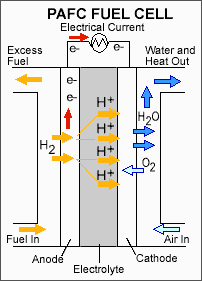|
For ad rates, send email to: info@PhosphoricAcidFuelCells.com "Changing the Way the World Makes and Uses Energy" SM
"Net Zero Energy" to Become $1.3 Trillion/year Industry by 2035
Austin, Texas info@PhosphoricAcidFuelCells.com
#NetZeroEnergy |
Phosphoric Acid
Fuel Cells
www.PhosphoricAcidFuelCells.com
What are Phosphoric
Acid Fuel Cells?
 Phosphoric
Acid Fuel Cells use liquid phosphoric acid as
an electrolyte—the acid is contained in a Teflon-bonded silicon carbide
matrix—and porous carbon electrodes containing a platinum catalyst. The
chemical reactions that take place in the cell are shown in the diagram to the
right.
Phosphoric
Acid Fuel Cells use liquid phosphoric acid as
an electrolyte—the acid is contained in a Teflon-bonded silicon carbide
matrix—and porous carbon electrodes containing a platinum catalyst. The
chemical reactions that take place in the cell are shown in the diagram to the
right.
The Phosphoric Acid Fuel Cell (PAFC) is considered the "first generation" of modern fuel cells. It is one of the most mature cell types and the first to be used commercially, with over 200 units currently in use. This type of fuel cell is typically used for stationary power generation, but some phosphoric acid fuel cells have been used to power large vehicles such as city buses.
Phosphoric
Acid Fuel Cells are more tolerant of
impurities in fossil fuels that have been reformed into hydrogen than other
fuel cells.
Phosphoric acid fuel cells are also less powerful than other fuel cells, given the same weight and volume. As a result, these fuel cells are typically large and heavy. Phosphoric acid fuel cells are also expensive. Phosphoric acid fuel cells require an expensive platinum catalyst, which raises the cost of the fuel cell. A typical phosphoric acid fuel cell costs between $4,000 and $4,500 per kilowatt to operate.
What is a Molten
Carbonate Fuel Cells?
Molten Carbonate Fuel Cells (MCFC) evolved from work in the 1960's aimed at producing a fuel cell which would operate directly on coal. While direct operation on coal seems less likely today, operation on coal-derived fuel gases or natural gas is viable.
|
|
For ad rates, send email to: info@PhosphoricAcidFuelCells.com
![]()
info@PhosphoricAcidFuelCells.com
Net Zero Energy Market to Become $1.3 Trillion/year
Industry by 2035 http://www.environmentalleader.com/2009/09/10/on-site-solar-poised-for-22-annual-growth/
Net Zero Energy Buildings Are Coming;
What About The Buildings Already Standing?
http://www.forbes.com/sites/justingerdes/2012/02/28/net-zero-energy-buildings-are-coming-what-about-the-buildings-already-standing/
The market for Distributed
PV, also known as "Rooftop
PV"
will be a $60 billion/year market by 2013!

![]()
Phosphoric Acid
Fuel Cells
www.PhosphoricAcidFuelCells.com
![]()
info@PhosphoricAcidFuelCells.com
PhosphoricAcidFuelCells.com
Copyright © 2003
All Rights Reserved
